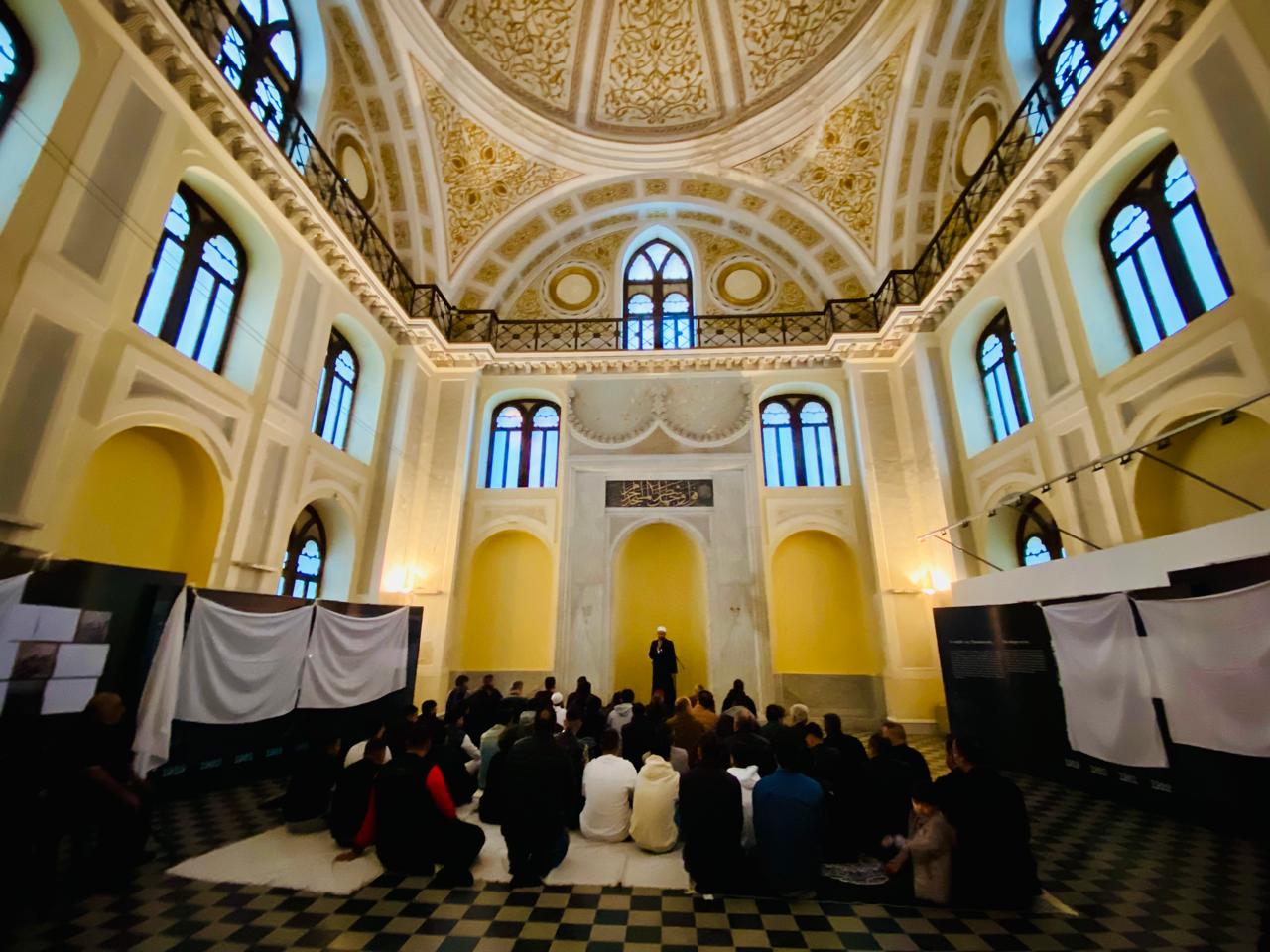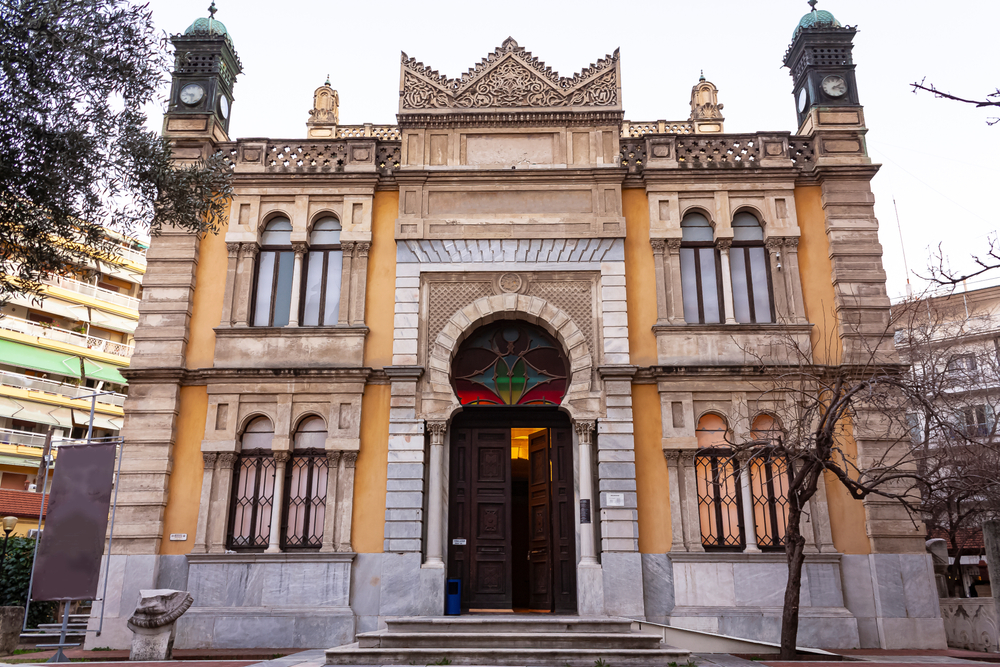
Prayer in the Yeni Cami - M.Drosopoulos/OBCT
For Eid, the Muslim holiday that marks the end of Ramadam, the city of Thessaloniki offered believers the opportunity to pray in the historic Yeni Cami: a highly symbolic act in a country with a large Orthodox majority
Dressed in his white linen shirt, the one he would normally wear only on Sundays and special occasions, Sechkin Tayip, a man in his late ‘20s, stands hesitantly at the gate of the ‘Yeni Cami’, the historic ‘New Mosque’. Despite living and working in the city as a cultural mediator for more than 5 years, it is the first time that he visits the iconic building.
What is more, today he is not a simple visitor, but a Muslim believer in an overwhelmingly Christian orthodox country, where he has finally been granted a place to pray other than a basement or a conference room.
Even if it is for just one day, the joy of being able to celebrate Eid Al Fitr in a public space, together with friends and family, comes with a daring thought, one which no longer seems unattainable: maybe this is city where he could finally belong.
For a fleeting moment, the young man lets himself bask in this reassuring feeling of ‘home’; one that he has been missing ever since fleeing his small town in Northern Iraq. His blissful thoughts are interrupted by a local police officer, asking him politely, in English, to search his backpack.
‘I need to go straight to work after the morning prayer’, responds Sechkin apologetically, in perfect Greek. The officer nods to the next person in line.
A mixture of 70 believers approximately, including both locals and tourists, have come to attend the Eid prayer. The word has spread from mouth to mouth; a few had even read about it.
‘We reserved the space for 100 people’, says a representative of the Ephorate of Antiquities of Thessaloniki, the agency overseeing this initiative. ‘Some might not know about it, while others might choose to pray in their own spaces. What matters is that this landmark building has been made available and there is high symbolism in this’.
Passing through a small garden, Sechkin is now facing the entrance. His gaze travels curiously over the butterfly-shaped, stained-glass window of the main door to the carved Stars of David adorning the top balconies, like vivid motifs embroidered on a fine strip of wool.
Entering the mosque barefoot, as prescribed by Islamic tradition, he leaves his shoes in a narrow corner on the right, reserved for this purpose. Paradoxically, the same place has been reserved for women, too. The few female believers, mainly members of the African community, are dressed in long, colourful dresses, covering them from head to toe. They stand timidly in that small corner, literally hidden behind a white banner that is blocking any view to the mihrab.
A few steps away, a parallel crowd has formed; one that is, in fact, wearing shoes. On the one side, dozens of journalists and photographers, both locals and foreign correspondents, have come to cover the event. On the other side, representatives of local authorities and policemen are watching vigilantly.
The instant that imam Taha Abdelgalil starts the prayer, flash cameras light up the New Mosque. A tide of cell phones rises up in the air, capturing the sight of worshippers repeating after the imam ‘God is Great’ before bending down to the small, individual rugs spread along the floor in lieu of a carpet.
Friendship, ignorance and controversy
The legendary ‘Yeni Cami’ was the last of its kind to be built in Ottoman Thessaloniki in 1902. It had been designed by architect Vitaliano Poselli, a Sicilian trained in Istanbul. Up until today, the New Mosque is considered a salient example of eclectic architecture, combing Neoclassical, Ottoman, Art Nouveau, Moorish, Baroque and Gothic elements with references to Jewish tradition.
This landmark building had originally been created for a unique population of Ottoman Thessaloniki: the so-called ‘Dönme’, that is, Sabbatean crypto-Jews who had formally converted to Islam to curry favour with the Sultan.
Ironically, they would eventually lead the rebel movement against the latter. After the Greek-Turkish war of 1919-22, the Dönme, along with other Muslim populations living in Greece, were “exchanged” with Christians in Turkey, as foreseen by the Treaty of Lausanne.
Over the following months, the New Mosque would host Christian refugees from Anatolia, before becoming the Archaeological Museum of Thessaloniki and eventually, the cultural and exhibition centre that it is today.
For Khaled Shahoud from Syria, 29, this is a day of celebration: ‘Ramadan is all about peace, community and gathering together. It is a present for us to have such a nice space, a mosque where we can practice our religion freely’.
Shahoud comments on the widespread ignorance over Islam that he encounters in his daily life: ‘Every year, when Ramadan starts, I need to explain to my colleagues why I neither eat nor drink anything during that month. They look at me surprised when I tell them that this is part of my religion’.
The news of the Yeni Cami opening its gates to Muslim believers made headlines to the national media. Most outlets portrayed this as a ‘historic’ event, happening in the second largest city of Greece for the first time in 100 years .
Nevertheless, this is not the first time in modern history that the New Mosque is being made available to the Muslim communities of the city, but rather the fourth. The previous three, however, had been somehow ambiguous, and as a result, tend to be overlooked.
The first time was in 2013 , under the administration of Mayor Yannis Boutaris, when the Yeni Cami opened its gates for the students of the Priestly School (Madrasah) of Komotini, a city in northeastern Greece, home to a sizeable Muslim minority.
A year later, in 2014, the New Mosque was offered again, but there was a strong debate over the profile of the imam who would conduct the prayer. The Greek government insisted that the imam should be someone officially appointed by the Greek state and not a person chosen by the ‘mufti’ elected by the Muslim minorities of Western Thrace – the Greek government does not recognise muftis elected in Thrace, many of whom have been at the heart of heated arguments over Turkish influence in the region. Opposing the government’s decision, a part of the Muslim population of Thessaloniki refused to attend the prayer.
In an effort to convey a message of friendship and unity, in 2018 the Boutaris administration eventually agreed to having the Ramadan prayer held by an imam and muezzin assigned by a mufti in the Western Thrace. This time, the prayer at the Yeni Cami was also attended by the Turkish Consul in Thessaloniki.
Nonetheless, the mayor’s decision raised criticism. Boutaris has made history as the contemporary mayor who opened Thessaloniki up to its Turkish and Balkan neighbours, projecting the city’s multicultural character as a crossroads of civilisations. He has received both praise and criticism over his extroversion strategy.
This year, the Greek government made it a prerequisite for the imam to be officially appointed by the state. This resulted in some communities expressing their disagreement by not attending the prayer.
Talking to OBCT, a Greek diplomat commented on this stance as ‘a misfortunate but predictable attempt to misuse religion for the sake of political interests’, emphasising that ‘such episodes should not overshadow the importance of this good initiative’.
blog comments powered by








